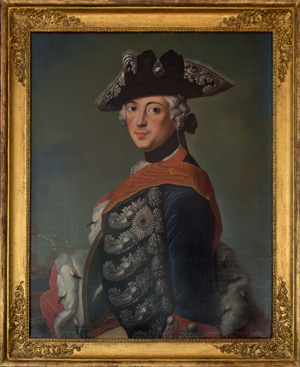Background to ‘The Music Book’
The Music Book was inspired by two 18th-century portraits and a 19th-century British passport in our family’s possession.
One portrait is of Frederick the Great of Prussia, believed to be by the painter Christian Friedrich Ziesenis (1729–1792).

The other was known only to us as the picture of the unknown man: an older, well-dressed, good-looking man, apparently painted in 1765, according to a faded handwritten label on the back (I have decided not to show the portrait here, to safeguard the novel’s – and the reader’s – image of the fictional character Carl Manfred von Deppe).
The passport, signed by the then British Foreign Secretary the Earl of Clarendon, was issued on 3 October 1853 to Mr Robert Whitfield, his wife and son for the purpose of “travelling on the Continent”. I found it in a Berlin flea market while rummaging through some German army travel warrants issued on the eve of the 1938 Munich conference.

Towards the end of 2011 I decided to write a fictional story linking the two pictures and the passport. The time span of the story – 1764 to 1766 – was arbitrarily set by the barely visible date of 1765 on the back of portrait of the unknown man.
The two main characters in the book are:
- A young woman, whom I have called Arabella Whitfield, a fictional ancestor of the man in the passport and
- Carl Manfred von Deppe, a fictional name for the unknown man in the picture.
The main historical character in the book is Frederick the Great, with incidental references to other historical personalities, such as Louis XV of France, providing a backdrop to the story.
The remaining characters – and of course the words spoken by the monarchs and the two documents written by Frederick – are fictional, except for Robert Whitfield and his family who really existed, albeit in the 19th century. It remains a matter of conjecture whether an ancestor of his ever made a similar journey across Europe almost a century before. I have simply used an author’s licence to recount such an event.
Since completing The Music Book, I have discovered the real identity of the man in the unknown painting to be Wilhelm Rudolf Daniel Ludwig Phillip von Gall, born in 1734 near Kirchhain, the third of eight children, who, in 1768, at the age of thirty-four, married Albertine Juliane von Curti, ten years his younger. An army officer, he fought first in the Seven Years War and later – from 1776 until 1781 – led his Hesse regiment, with various controversial ups and downs, alongside British forces in Canada and then during the American War of Independence. On his return to Hesse, he had an equally controversial career, culminating in his appointment as Marshal of the Court of the Elector William the First. Von Gall died in 1799.
The emergence of the sitter’s real identity presented me with a dilemma. Should I rewrite the story to fit – in a more biographical way – the facts that had come to light or leave it as it was? Rather than lose the fictional connection with Frederick the Great and expunge the character of the feisty and beautiful Arabella Whitfield, I decided no change was necessary.
Nonetheless, von Gall’s military career provides a rich vein of material and ideas for the sequel to The Music Book. This will address what happened next to Carl Manfred and Arabella.
Finally, with yet another twist, a German art expert living in Potsdam has told me that the painter of the von Gall picture is most likely Anton Wilhelm Tischbein. He was born in 1730 in Haina, the youngest of five sons of a master baker. Each son became a painter, including the important and most well-known Johann Heinrich Tischbein the Elder. Known as the Hanauer Tischbein, Anton painted not only the family members of his royal masters but also other wealthy patrons, including those resident in Frankfurt.
